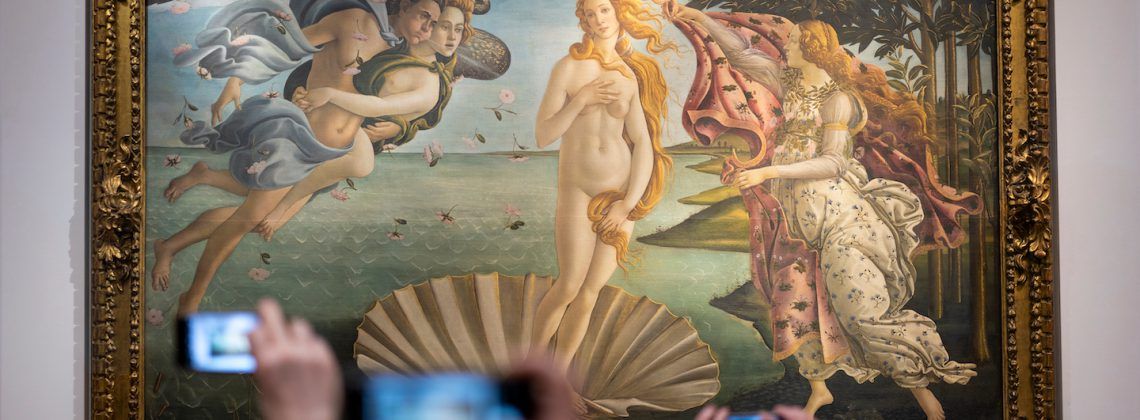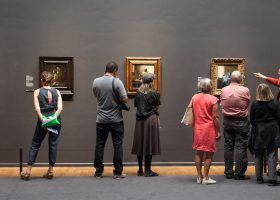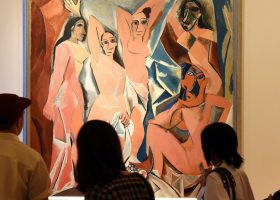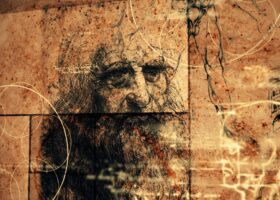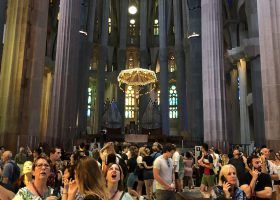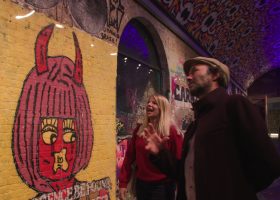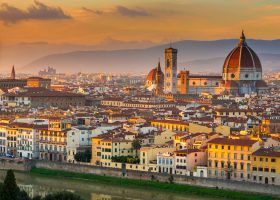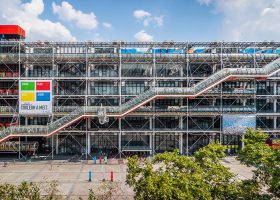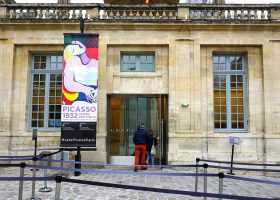Sandro Botticelli, the goldsmith’s apprentice who traded metalwork for paintbrushes, became the Renaissance’s poet of beauty and motion. From mythic goddesses floating on seashells to frescoes inside the Sistine Chapel, his work still stops crowds cold. Use this article as your shortcut through centuries of art history to the very rooms that house his masterpieces.
The 11 Most Famous Works of Art By Botticelli
Botticelli’s artistic career spans some of the most iconic paintings in Western art history, each full of layered meaning and unforgettable beauty. His subjects ranged from saints and angels to ancient goddesses and political drama. Here are 11 of Botticelli’s most famous works, including where you’ll find them.
11. St Sebastian
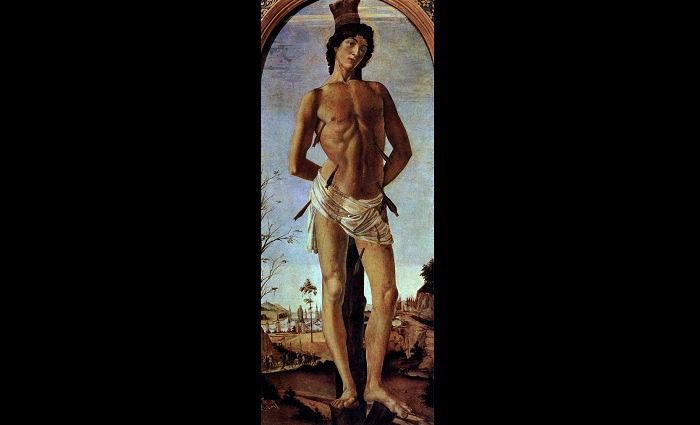
1474 | Tempera on panel | Gemäldegalerie (Berlin)
The image of this saint is very precarious. Botticelli painted a very tall, slender, and sort of scrawny figure clearly in suffering. According to Emile Gebhart and Victoria Charles, Botticelli here references Donatello’s canon of proportions. This meant creating a slightly exaggerated slender figure, contrary to what his master taught him—full, rounded bodies. In doing this, he achieves a sense of majesty in the depiction of the human figure.
It’s important to understand the historical context to appreciate why Botticelli would have painted this saint. According to Barbara Deimling, during this time St. Sebastian was one of the most venerated saints in Italy as patron of those infected by the plague.
Deimling suggests this painting was probably an expression of gratitude for being spared from the plague. It’s not a very common motif, so hopefully, you will remember it in this collection.
Where to see it: Gemäldegalerie, Berlin
Top Hotels in Berlin

The Mandala Suites ⭐⭐⭐⭐
Stylish · Luxury Spa · Central
Spacious suites, modern amnetities, and friendly staff make this a great base for a multi-day stay in Berlin.
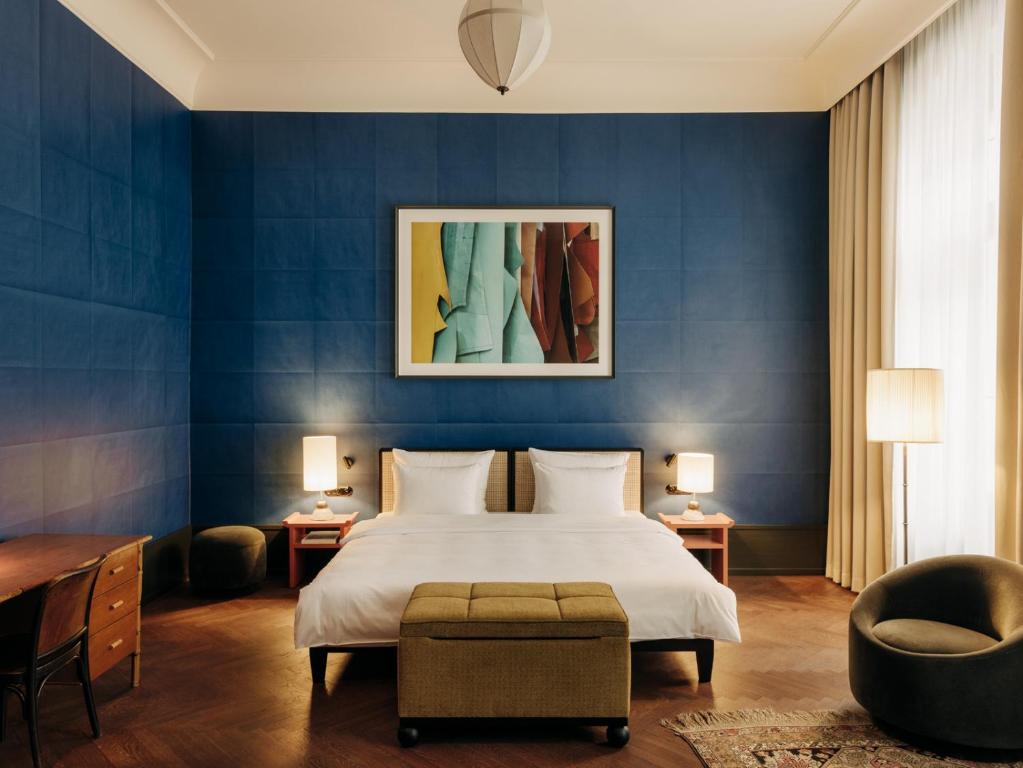
Château Royal ⭐⭐⭐⭐⭐
24 Hour Service · Terrace · Family Rooms
With family rooms, classy suits, and standard double rooms, plus an onsite restaurant, this hotel is perfect for those seeking convience with class.
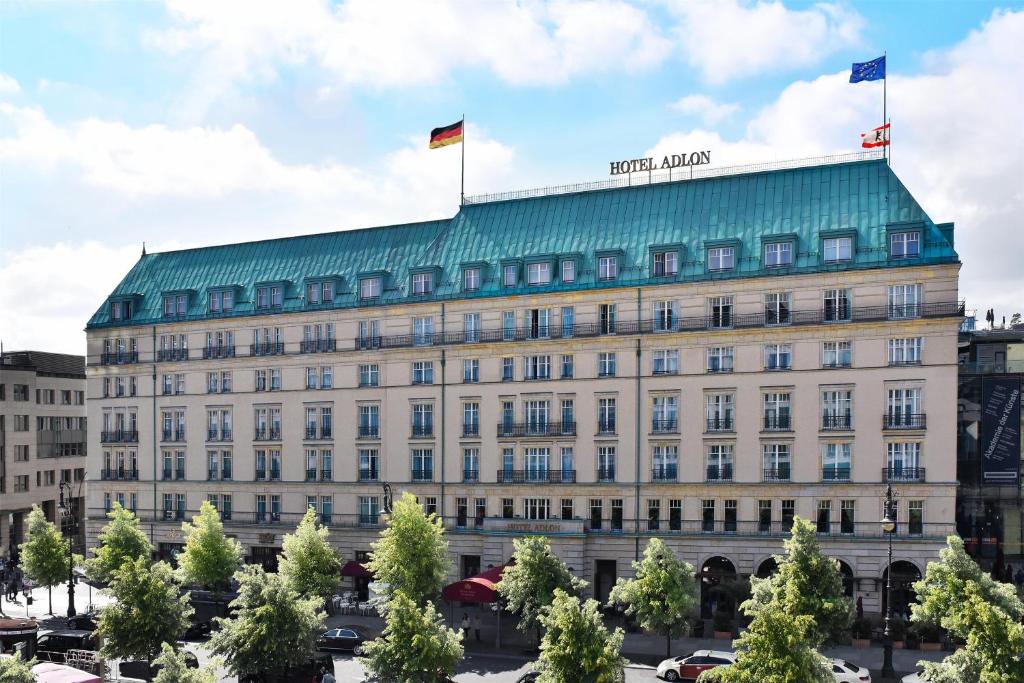
Hotel Adlon Kempinski ⭐⭐⭐⭐⭐
Sophisticated · High-End · Central
If you have the budget, this legendary 5-star hotel is a must-stay. Between the Michelin Star restaurant and modern amenties, you’ll feel like royalty yourself.
10. Annunciation
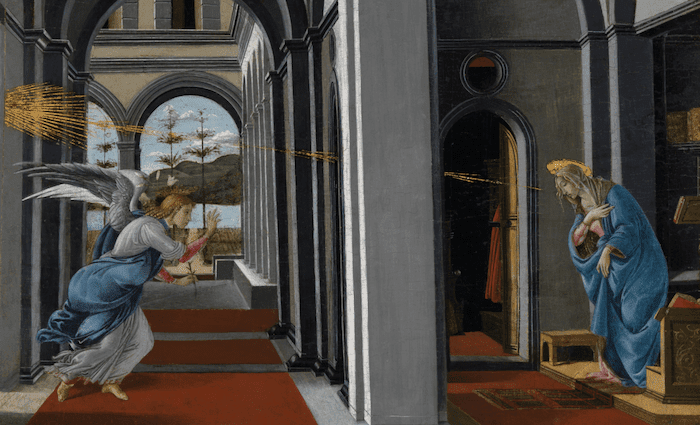
1490 | Tempera on panel | Kelvingrove Art Gallery and Museum (Glasgow)
This painting by Botticelli presents a variant of the Annunciation where the Virgin Mary is reading and the angel appears to bring the news that she is pregnant with the child of God.
We think Botticelli took inspiration for this painting from Verrochio, who was Leonardo da Vinci’s teacher. However, this motif of Mary and the angel was likely something he learned from his master Fra Filippo, who also created an annunciation with this same style.
The most striking element of this painting is the use of architectural features to frame the narrative. You can see this in the position of the columns, the arches, and the flooring, which create a very interesting perspective and give the impression that this could be a real building.
The Annunciation has been one of the most common religious Christian art motifs since the Middle Ages. Almost every grandmaster has a piece on the Annunciation. So, we understand this piece as one of the stepping stones in Botticelli’s artistic career.
He also created other versions of the Annunciation. And you can see one of these, the Cestello Annunciation, which is a more simplified composition, at the Uffizi (Florence), and another one in the Metropolitan in New York.
Where to see it: Kelvingrove Art Gallery and Museum, Glasgow
9. Callumny of Apelles
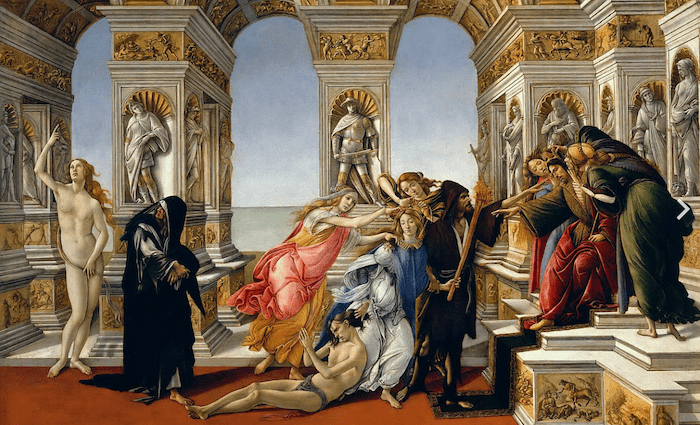
1494-5 | Tempera on panel | Uffizi (Florence)
This is one of Botticelli’s most famous paintings because it is his best depiction of the ekphrasis genre. An ekphratic painting is a rhetorical device that tries to relate to another art medium and recreate its essence and form.
It’s a mixture between adaptation and synergy. Here, Botticelli is trying to recreate a lost painting from the ancient Greek artist Apelles based purely on a description found in commentaries by Pliny the Elder and Lucian.
The figures represent vices and virtues. This is a very complex painting with many meanings and allegories that are still difficult for art historians to digest. This is because we don’t know who exactly it was intended for. Unfortunately, as the original painting is also lost, we cannot draw many comparisons between the two.
Planning a trip to Florence? Don’t go with a big group to the Uffizi. Instead, check out our small group tours that allow you to connect with your guide and really understand the artwork.
Where to see it: Uffizi Gallery, Florence
Top Hotels in Florence
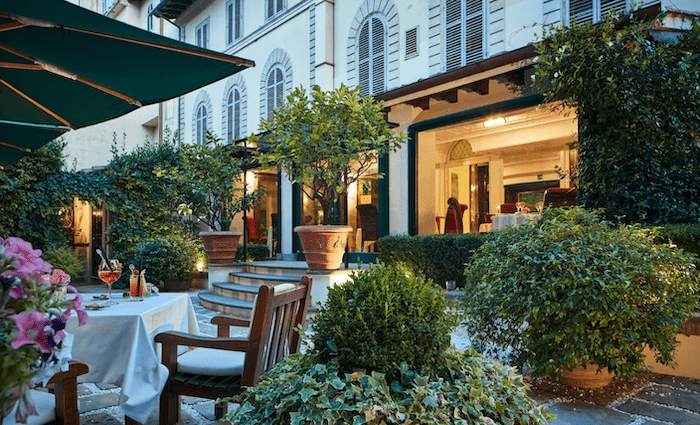
Hotel Regency ⭐⭐⭐⭐⭐
Small Luxury Hotel · Quiet · Urban Garden
Famly friendly hotel with outdoor garden and seating area, perfect for unwinding after a long day.
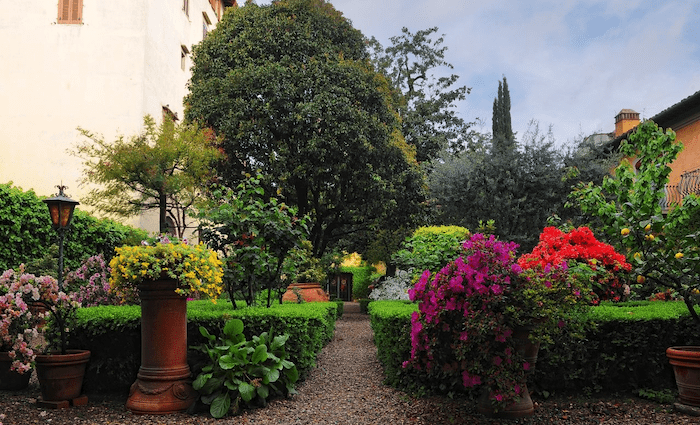
Hotel Monna Lisa ⭐⭐⭐⭐
Near Duomo · Antique Furniture · Courtyard
Classic hotel set in a 15th-century building. Central and quiet with elegantly decorated rooms.
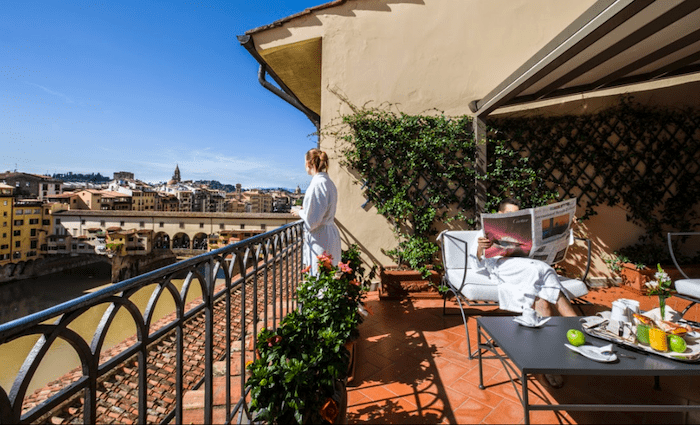
Hotel degli Orafi ⭐⭐⭐⭐
Rooftop Bar · Large Rooms · Near Uffizi
Former Augustine convent turned quiant hotel with a rooftop garden bar and stunning views of the Cathedral.
8. Portrait of Smeralda Bandinelli
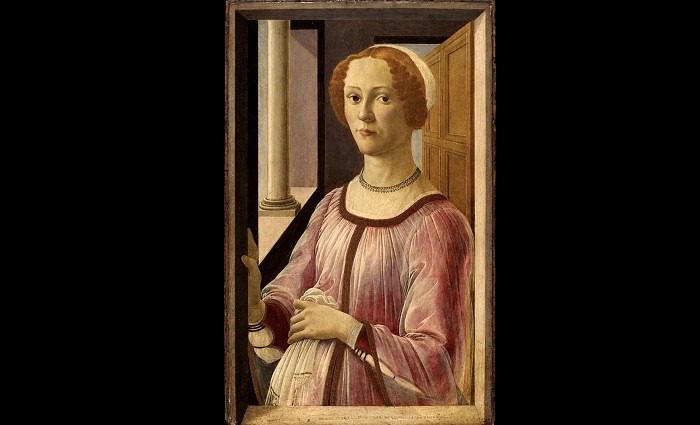
c. 1470 | Tempera on panel | Victoria and Albert Museum (London)
Botticelli was among the first wave of artists in the Renaissance to change portraits, which encouraged artists to work on three-quarter portraits. This trend was started by Flemish artists.
In the 1470s, Botticelli worked on several projects where he innovated with his artistic facial expressions. But for this portrait, specifically, he added a new feature.
Patricia Zambrano explains that he presents the portrait as if it is seen through an opening and in an architectural setting. This was a type of feature that he mastered and used frequently, so Botticelli gave it a new space in portraiture.
Also, according to Zambrano, this is the first known female portrait of this kind. Costaras and Richardson explain that this painting was repaired by Rossetti in the 19th century and somehow altered. They also state that Botticelli added oil to his tempera paintings to give them more of a sophisticated range of effects, and that is visible in this painting.
Where to see it: Victoria and Albert Museum, London
Top Hotels in London
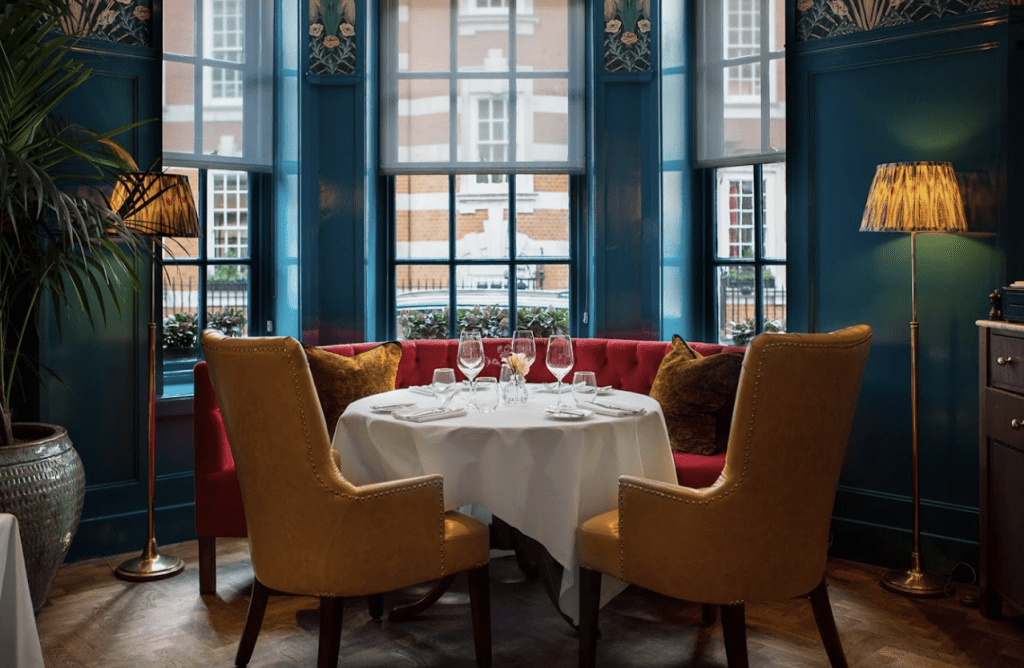
The Marylebone Hotel ⭐⭐⭐⭐⭐
Near Soho · Large Pool · Room Service
This hotel stands out for its elegant bedding, convenient on-site restaurants, and attentive concierge service.
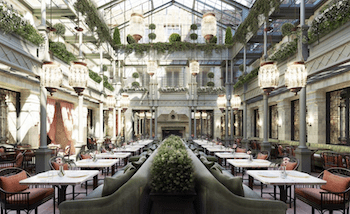
NoMad London ⭐⭐⭐⭐⭐
Amazing Communal Areas · Covent Garden Location
Old-world charm meets modern luxury at this 5-star hotel conviently located near Leicester Square.

The Gate Hotel ⭐⭐⭐⭐
Apartment Style · Fitness Center · Great Value
Modern, cozy, and affordable—just right for families or travelers who want everything within easy reach.
7. Madonna of the Magnificat
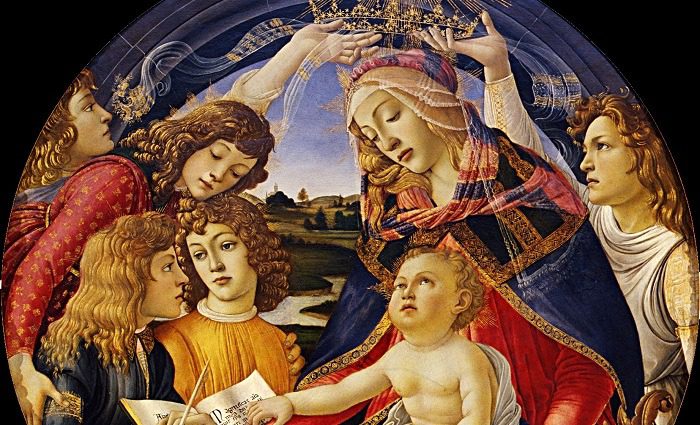
1481 | Tempera tondo | Uffizi (Florence)
This is a painting of Madonna and the child, with the virgin holding a pomegranate—a symbol of resurrection, according to Carlo Montresor. It shows that Botticelli had great knowledge of movement, which can be seen both in the bodies of the Madonna and Jesus and in the landscape in the background, specifically the river.
The name of the painting comes from the page baby Jesus is holding over his mother’s arm–there, you’ll see the words for the Magnificat. In fact, according to Schibanoff, the Madonna is represented here not as a passive reader, as most virgins with a child and book are.
Instead, if you look closely, you’ll see she’s holding a pen and writing this Magnificat text. Again, another mysterious and unusual touch of Botticelli in this painting has created much debate amongst historians.
Where to see it: Uffizi Gallery, Florence
Not ready to book a tour? See our Uffizi Gallery Guide for more info.
6. The Tragedy of Lucretia
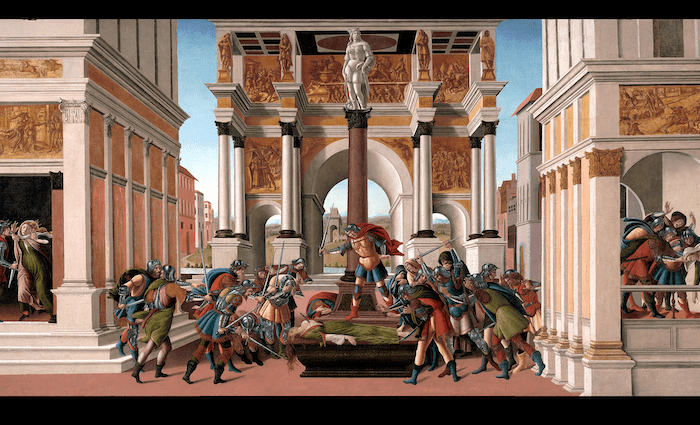
1496-1504 | Tempera and Oil on Wood | Isabella Stewart Gardner Museum (Boston)
The painting is a dramatic representation of the raping of Lucretia by Sextus Tarquinius, the son of the last king of Rome. The ravaging of Lucretia starts on the panel on the left.
The centre panel represents the burial of Lucretia and the men of Rome taking arms and rebelling against the powers of the city for such a felony. This eventually leads to the founding of the roman republic.
On the right-hand panel, Lucretia appears to take her own life after she reveals what has happened to her. Botticelli uses the building to set the scene almost as if it were a tryptic in three sections, which is a very clever way of displaying perspective and storytelling.
It’s unclear whether the building represents old Rome or a landscape contemporary to Botticelli. According to Barbara Deimling, Botticelli uses this story to allude to contemporary historical events, particularly the ousting of the Medici, who were his patrons, and the introduction of the Florentine republic. This, then, was a very political painting for him, particularly considering his general standing in mythology and religious art.
Where to see it: Isabella Stewart Gardner Museum, Boston
Top Hotels in Boston

Canopy By Hilton ⭐⭐⭐⭐
Central · Fitness Center · Stylish
Thoughtful amenities and a top-notch location make this a smart pick for families or couples exploring Boston on foot.

Omni at the Seaport⭐⭐⭐⭐
Rooftop Pool · Spa & Fitness
Stylish, central, and packed with perks—this hotel puts Boston’s best right at your doorstep.
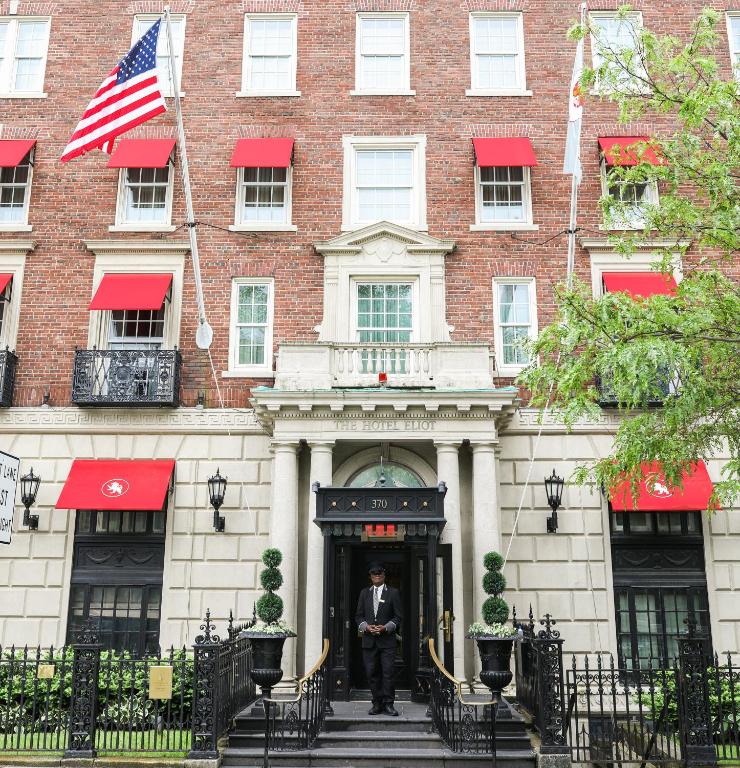
The Eliot Hotel ⭐⭐⭐⭐⭐
Historic Charm · Back Bay · Luxury
Built in 1925 and still a Boston icon, The Eliot Hotel combines classic luxury with modern comforts.
5. Youth of Moses
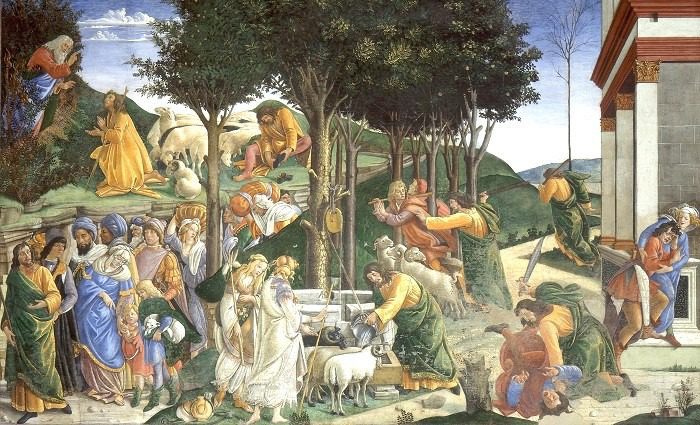
1481-2 | Fresco | Sistine Chapel (The Vatican)
Also known as The Trials of Moses. This is part of a series of frescoes showing several scenes from Exodus commissioned by the Renaissance popes to adorn the Sistine Chapel. Botticelli was one of many artists who participated in this project.
This was also one of the very few times where he actually worked outside of Florence. Because the project was so big, he actually used his apprentices to help him create the scenes much the same as Michelangelo did for the Sistine Chapel.
Moreover, he and his team created a total of three frescoes telling the stories of Moses and Jesus. You can always tell who is Moses in these frescoes because his tunic is yellow and he wears a green cloak. The importance of these paintings is mainly in the magnitude of the work and their location in this room.
There’s more to the Sistine Chapel than meets the eye. If you want to have the privilege of seeing the Sistine Chapel ahead of the crowds, check out our early-access Vatican tours with a guide who really knows their stuff.
Where to see it: Sistine Chapel, Vatican
Top Hotels in Rome
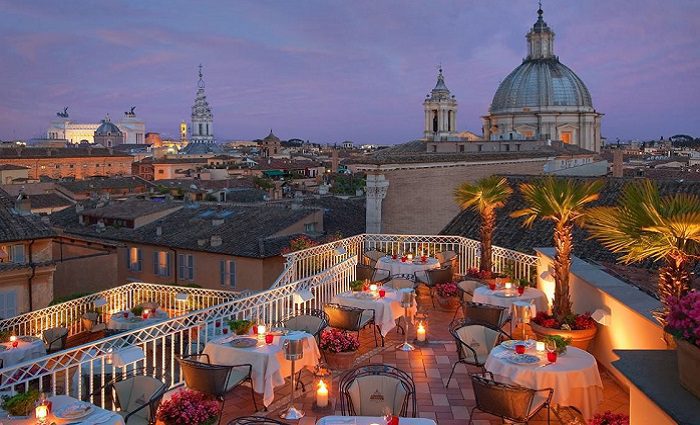
Bio Hotel Raphael ⭐⭐⭐⭐⭐
Piazza Navona • Terrace
Luxury hotel with a rooftop restaurant plus spacious and calming suites near Piazza Navona.
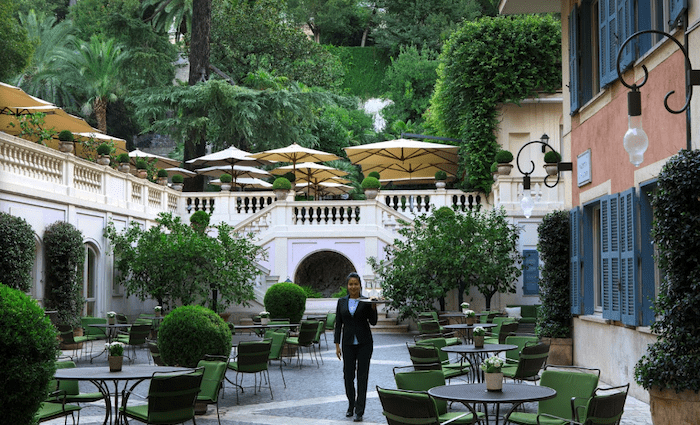
Hotel de Russie ⭐⭐⭐⭐⭐
Timeless Luxury • Spanish Steps
Popular hotel for VIPs like Bruce Springsteen with a classic Italian style and a dreamy courtyard.
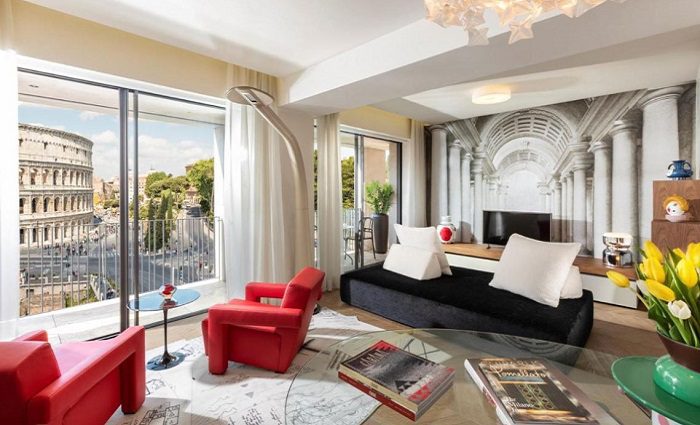
Palazzo Manfredi ⭐⭐⭐⭐⭐
Luxury • Near Colosseum • Terrace
Wake up to views of the Colosseum and enjoy meals on a stunning terrace in this top hotel in Monti.
4. Adoration of the Magi
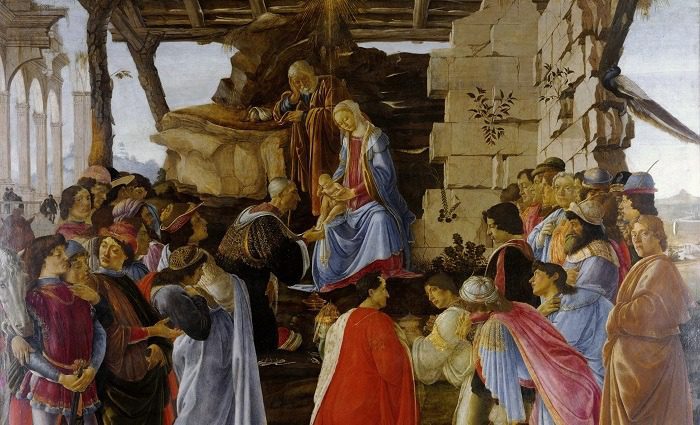
1476 | Tempura on panel | Uffizi (Florence)
According to Carlo Montresor, this is a crucial artistic step in Botticelli’s career as a painter. It helped him find his way and his voice as an artist. However, the reason why this painting is most famous is because of the depiction of some famous people of the time.
According to Isabella Alston, the magi are painted as Cosimo de Medici and his sons, Piero and Giovanni, all of whom were already dead at the time of the painting. It was his first introduction to the Medici family and, therefore, the prospect of a lucrative future ahead.
Finally, Barbara Deimling states that the retinue of the magi is painted in very luxurious clothes. This is reflective of the parades of the Florentine brotherhood of the magi who imitated the procession of the magi from the Bible. So, this painting helps us understand some cultural celebrations in Florence during this period.
Where to see it: Uffizi Gallery, Florence
Not ready to book a tour? Find out how to visit the Uffizi Gallery.
3. The Mystical Nativity
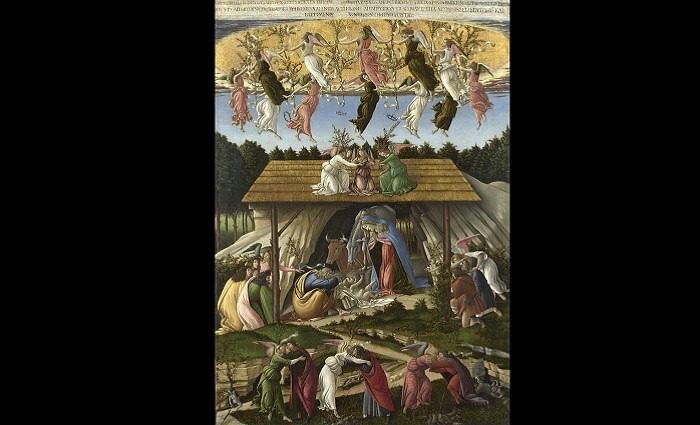
c. 1500-1| Oil on canvas | National Gallery (London)
This is the only painting Botticelli signed. As a depiction of the nativity scene, it shows some unusual iconography. Anyone familiar with a nativity scene of any medium would know the three wise men brought Jesus gifts.
However, there are no presents here. Christ also seems rather distressed. According to art historian Jonathan Nelson, the depiction of the angels and demons also has a resonance with paintings of the Last Judgment and the Apocalypse. So, perhaps Botticelli was alluding to the fact that Christ would return and judge our souls.
This coincides perfectly with the timeframe in which Botticelli was associated with a radical Christian preacher called Girolamo Savonarola. He was very vocal against the ruling despots of Italy and the treatment of the poor and secular art and vanities.
His calls for a renovation of Christianity had a feeling of doom looming. They seemed to come true as the first Italian War of 1494-98 took place, which eventually lead to the removal of the Medici as the ruling family in Florence.
Interestingly, Savonarola was later excommunicated by the Pope and hanged. His radical preaching is definitely something Botticelli sympathized with and is exemplified in this painting.
Where to see it: National Gallery, London
2. Primavera
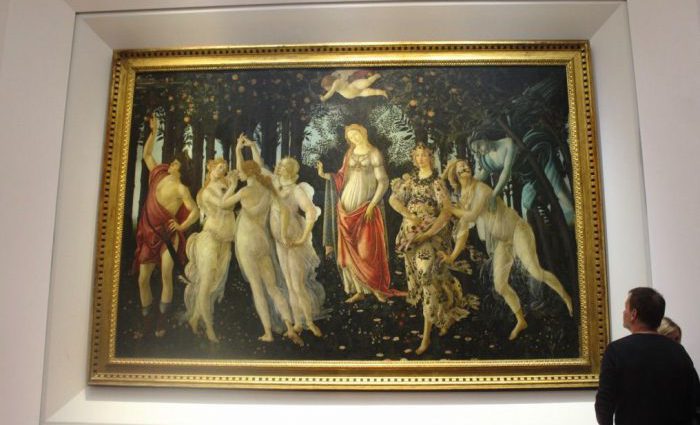
c. 1479-80 | Tempera on panel | Uffizi (Florence)
This is the largest mythological painting created in the early Renaissance. According to Isabella Alston, perhaps this was conceived as a painting to commemorate a wedding.
The themes of love and marriage seem to resonate with this. However, Jean Gillies suggests this is one of the most debated paintings in history. In fact, scholars often considered it rather enigmatic.
Nevertheless, art historians concur that this painting represents the deep impact humanism had on Renaissance artists such as Botticelli. Also, if we accept the traditional interpretation that the painting was commissioned by the Medici, we can also see traces of these patrons and their ideologies.
The Medici were firm believers of Neoplatonism, which merged Christian ideology with Plato’s philosophies. This could have added to the mysticism of the iconography used in the painting.
Furthermore, according to Jean Gillies, recent inventories discovered suggest the painting was done for Lorenzo de Medici, or at least that it was in his possession for a long time. So, it must have had some meaning to him.
According to Carlo Montresor, these inventories referred to it as the garden of Atlantis or the garden of the Hesperides. This makes sense if we consider that Botticelli never gave a name to this painting. The name “Primavera” comes from accounts written by Vasari where he calls it bythis name.
Where to see it: Uffizi Gallery, Florence
Top Hotels in Florence
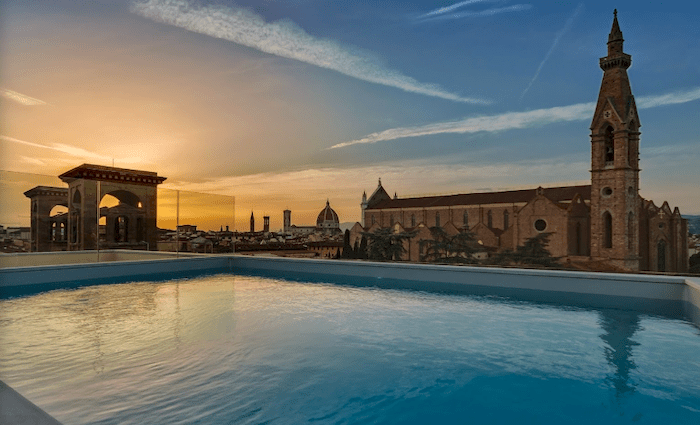
Plaza Hotel Lucchesi ⭐⭐⭐⭐
Rooftop Pool · Family Friendly · Santa Croce
Simple hotel with classic charms and an epic pool perfect for hot summer days.
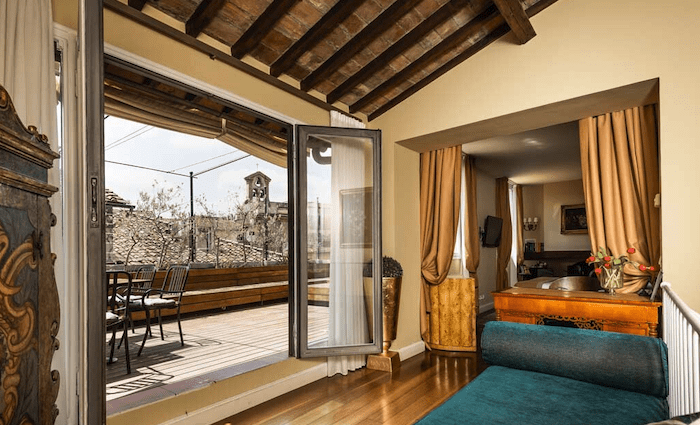
Aqa Palace ⭐⭐⭐⭐
Santa Croce · Rooms & Apartments
Great value hotel that’s neatly decorated. Perfect for those looking for extra space.
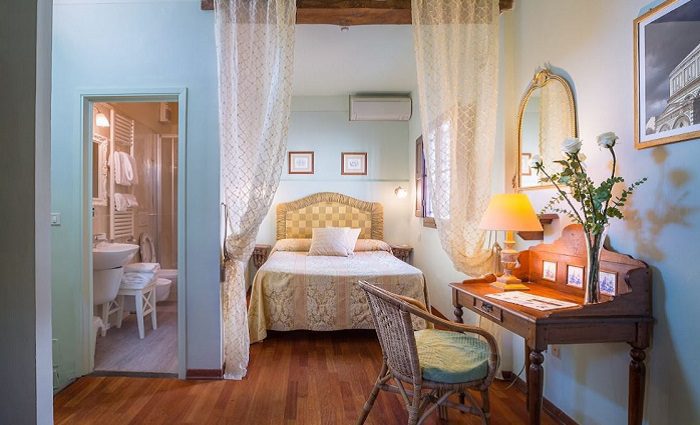
Hotel Torre Guelfa ⭐⭐⭐⭐
Unique Rooms · Terrace · Pet Friendly
Set in a restored medieval tower, this upscale stay combines antique elegance with comfort.
1. The Birth of Venus
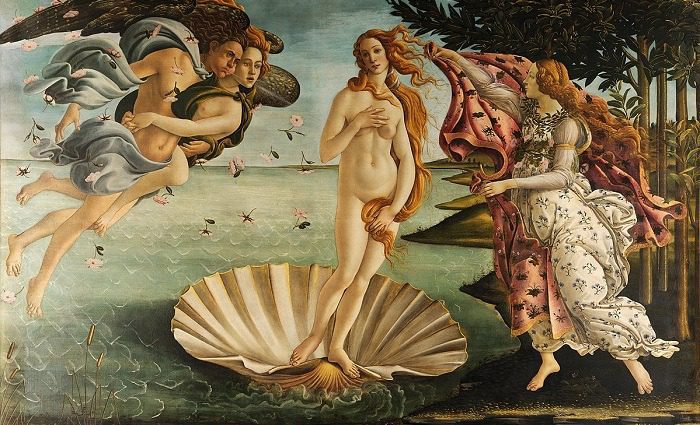
1484-6 | Tempera on canvas | Uffizi (Florence)
This is the most iconic of Sandro Botticelli’s paintings thanks to the popularity it has gained in recent years. According to Isabella Alston, it is historically the first work in tempera on canvas created in Tuscany.
Another incredible feature Botticelli added to this painting was the alabaster powder he added to his paints to make the colors pop and act as a preservative at the same time.
According to Isabella Alston, the body of this venus and its sensuality simulates marble statues of the goddess. This explains the emphasis on making it as pale and marble-like as possible. Her modest stance as she tries to cover herself is a direct reference to the Venus Pudica of classical art.
Most art historians believe this is a very allegoric painting that draws inspiration from Ovid’s metamorphosis stories. Isabella Alston suggests that the model for this painting may have been Simonetta Cattaneo Vespucci, who was his love interest.
Unfortunately, she died young (21) of suspected tuberculosis. The fact that he never married and asked to be buried at the foot of her grave emphasizes his adoration for this woman and she may have been the inspiration for this Venus.
Now that you understand Botticelli better, you can more fully appreciate the exceptional work of Botticelli. If you want to see The Birth of Venus and other artworks on this list, plan a visit to the Uffizi in Florence.
Where to see it: Uffizi Gallery, Florence
Not ready to book a tour? Find out if an Uffizi Gallery tour is worth it.
More Intriguing Facts About Sandro Botticelli
Who was Sandro Botticelli?
A Florentine painter born in 1445, Botticelli trained under Fra Filippo Lippi, ran his own workshop by 1470, and became famous for mythological and religious scenes that defined Early Renaissance style.
Where can I see Botticelli paintings today?
The largest collection sits in Florence’s Uffizi Gallery, but key works also hang in London’s National Gallery, Berlin’s Gemäldegalerie, Boston’s Isabella Stewart Gardner Museum, and the Vatican’s Sistine Chapel.
What is Botticelli’s most famous artwork?
The Birth of Venus (1484-86), a tempera-on-canvas masterpiece at the Uffizi, is widely considered his signature painting.
Did Botticelli paint in the Sistine Chapel?
Yes—he completed three frescoes, including The Youth of Moses, for Pope Sixtus IV around 1481-82.
Why did Botticelli’s reputation fade after his death?
High Renaissance tastes shifted toward Michelangelo’s muscular style, leaving Botticelli’s elegant figures out of fashion until Pre-Raphaelite artists revived interest in the 19th century.
